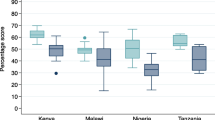Abstract
Objective
To develop a composite index that serves as a proxy marker of quality of clinical service and pilot test its use in 11 special neonatal care units (SNCUs) across two states in India.
Design
Secondary data from SNCU webportal.
Settings
Special new-born care units in Rajasthan and Orissa.
Intervention
We developed a composite SNCU Quality of care Index (SQCI) based on seven indices from SNCU online database. These included rational admission index, index for rational use of antibiotics, inborn birth asphyxia index, index for mortality in normal weight babies, low birth weight admission index, low birth weight survival index, and optimal bed utilization index.
Outcome
Based on the SQCI score, the performance of SNCUs was labelled as good (SQCI 0.71–1.0), satisfactory (SQCI 0.4–0.7) or unsatisfactory (SQCI <0.4).
Results
The mean difference in SQCI between Jan-Mar 2016 and 2017 was 0.20 (95% CI 0.13–0.28; P<0.001). Similar results were obtained for rational admission index, rational use of antibiotics, mortality in normal weight babies, low birth weight survival and optimal bed utilization. A significant improvement in the overall composite score was noted in Odisha (Mean difference 0.22, 95% CI 0.11–0.33, P=0.003) and Rajasthan (Mean difference 0.17, 95% CI 0.05–0.3, P=0.002).
Conclusion
QI approach using SQCI tool is a useful and replicable intervention. Preliminary results show that it does lead to strengthening of implementation of the programs at SNCUs based on the comprehensive scores generated as part of routine system.
Similar content being viewed by others
References
Facility based newborn care: Operational guidelines. In: Ministry of Health and Family Welfare, editor. New Delhi: Ministry of Health and Family Welfare, Government of India; 2011.
Ministry of Health and Family Welfare. Health Management Information System. In: Ministry of Health and Family Welfare, editor. Ministry of Health and Family Welfare, Govt of India; 2017.
MOHFW. Special Newborn Care Units in India. In: Ministry of Health and Family Welfare, editor. New Delhi 2017.
Strengthening Facility Based Paediatric Care: Operational Guidelines for Planning & Implementation in District Hospitals. In Child Health Division, Ministry of Health and Family Welfare, Government of India, New Delhi. September 2015. Accessed on November 16, 2020. Available from: https://nhm.gov.in/images/pdf/programmes/child-health/guidelines/Strenghtening_FacilityBasedPaediatricCare-OperationalGuidelines.pdf
Neogi SB, Malhotra S, Zodpey S, Mohan P. Assessment of special care newborn units in India. Health Pop Nutr. 2011;29:500–9.
Neogi SB, Malhotra S, Zodpey S, Mohan P. Challenges in scaling up of special care newborn units-Lessons from India. Indian Pediatr. 2011;48:931–5.
Sharma G, Powell-Jackson T, Haldar K, Bradley J, Filippi V. Quality of routine essential care during childbirth: Clinical observations of uncomplicated births in Uttar Pradesh, India. Bull World Health Organ. 2017;95:419–29.
Iyengar K, Jain M, Thomas S, et al. Adherence to evidence based care practices for childbirth before and after a quality improvement intervention in health facilities of Rajasthan, India. BMC Pregn Childbirth. 2014;14:270.
Chauhan M, Sharma J, Negandhi P, Reddy S, Sethy G, Neogi S. Assessment of newborn care corners in selected public health facilities in Bihar. Indian J Public Health. 2016;60:341–6.
Chawla D, Suresh GK. Quality improvement in neonatal care — A new paradigm for developing countries. Indian J Pediatr. 2014;81:1367–72.
Neogi SB, Malhotra S, Zodpey S, Mohan P. Does facility-based newborn care improve neonatal outcomes?. A review of evidence. Indian Pediatrics. 2012;49:651–58.
Sarin E, Kole SK, Patel R, et al. Evaluation of a quality improvement intervention for obstetric and neonatal care in selected public health facilities across six states of India. BMC Pregn Childbirth. 2017;17:134.
Neogi SB, Shetty G, Ray S, Sadhukhan P, Reddy SS. Setting up a quality assurance model for newborn care to strengthen health system in Bihar, India. Indian Pediatr. 2014;51:136–8.
Vagias WM. Likert -type scale response anchors. Clemson University: Department of Parks, Recreation and Tourism Management, 2006.
Nadeem E, Olin SS, Hill LC, Hoagwood KE, Horwitz SM. Understanding the components of quality improvement collaboratives: a systematic literature review. Milbank Q. 2013;91:354–94.
Mehndiratta A. Quality Improvement of Facility Based New Born Care in India: ACCESS health International; 2014; Available from: http://accessh.org/wp-content/uploads/2014/07/Quality-Improvement-of-Facility-Based-Newborn-Care-in-India-Poster.pdf
Sharma J, Neogi S, Negandhi P, Chauhan M, Reddy S, Sethy G. Rollout of quality assurance interventions in labor room in two districts of Bihar, India. Indian J Public Hlth. 2016;60:323–8.
Horbar JD. The Vermont Oxford Network: Evidence-based quality improvement for neonatology. Pediatrics. 1999;103:350–9.
Horbar JD, Rogowski J, Plsek PE, et al. Collaborative quality improvement for neonatal intensive care. NIC/Q Project Investigators of the Vermont Oxford Network. Pediatrics. 2001;107:14–22.
Hernández-Borges AA, Pérez-Estévez E, Jiménez-Sosa A, et al. Set of quality indicators of pediatric intensive care in Spain: Delphi method selection. Pediatr Qual Safety. 2017;2:e009.
Profit J, Zupancic JA, Gould JB, et al. Correlation of neonatal intensive care unit performance across multiple measures of quality of care. JAMA Pediatr. 2013;167:47–54.
Lachman P, Jayadev A, Rahi M. The case for quality improvement in the neonatal intensive care unit. Early Human Dev. 2014;90:719–23.
Author information
Authors and Affiliations
Corresponding author
Additional information
Contributors
HK: conceptualized SQCI and provided technical oversight of the process of SQCI analysis and use; RK: developed the statistical model during conceptualization of SQCI, analyzed data, interpreted the results and contributed to writing of the manuscript. VA,AK: provided technical support during conceptualization of SQCI, monitoring indicators and reviewed the manuscript; AAB: contributed in the framing of monitoring indicators and reviewed the manuscript SBN: reviewed the literature and drafted the manuscript; PC,PKS: implemented SQCI in their respective states, reviewed manuscript and provided inputs.
Funding
This study was conducted as part of the Newborn care project supported by Norway India Partnership Initiative (NIPI)
Competing interest
None stated.
Rights and permissions
About this article
Cite this article
Kumar, H., Khanna, R., Alwadhi, V. et al. Catalytic Support for Improving Clinical Care in Special Newborn Care Units (SNCU) Through Composite SNCU Quality of Care Index (SQCI). Indian Pediatr 58, 338–344 (2021). https://doi.org/10.1007/s13312-021-2192-8
Received:
Revised:
Accepted:
Published:
Issue Date:
DOI: https://doi.org/10.1007/s13312-021-2192-8



